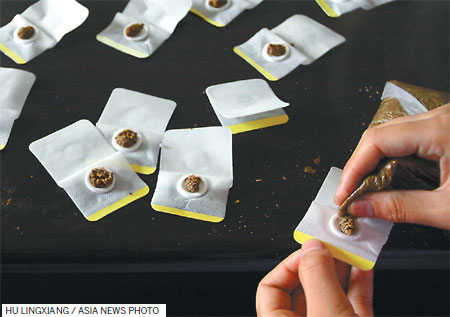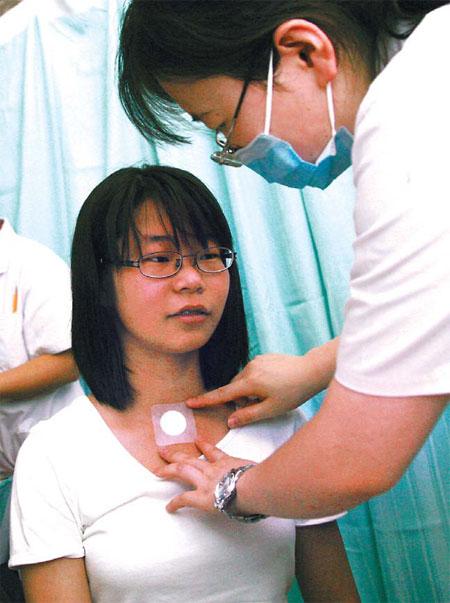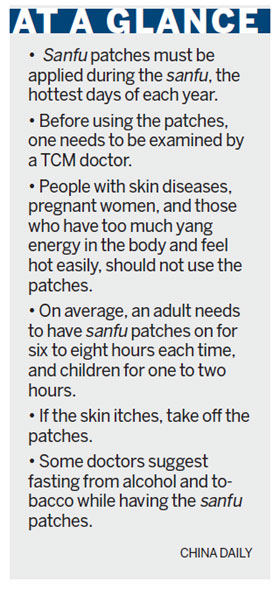Patchwork solutions

 |
|
Medicinal patches are applied to varied acupuncture points to treat different diseases. Ma Di / for China Daily |

It is a little patch of Chinese herbs that is believed to correct the body's internal balance and works best as the hottest days of the year descend on us.
Liu Zhihua speaks to doctors and patients on why more are waiting in line for this summer panacea.
It is a herbal patch named after the three hottest periods of the year according to the lunar calendar. Sanfu started on July 18 this year, and as each period lasts 10 days, it will span a period of 30 days. These patches have been used in traditional Chinese medicine (TCM) since the earliest recorded times according to Huangdi Neijing (The Inner Canon of the Yellow Emperor), more than 2,000 years ago, the time-tested textbook for TCM practitioners. Sanfu patch treatment became extremely popular in the Qing Dynasty (1644-1911) and enjoyed a revival in recent years as more patients turn to TCM treatment.
But its popularity this summer has caught even the professionals by surprise.
"We knew there would be a lot of demand for sanfu patches treatment, but we didn't expect the hospital to be filled to capacity," says Zhang Shu'nan, a TCM specialist of respiratory diseases at the China-Japan Friendship Hospital in Beijing.
"All the patches we prepared were used up the first day, and we have received calls from other hospitals looking for patches," Zhang says.
The treatment is based on the TCM principle of yin and yang, which believes the balance of both elements in the body is vital for good health.
When yang is lacking, chronic diseases attributed to a "cold nature", such as coughing, asthma, arthritis, dysmenorrhea and irregular menstruation will take place or get worse in winter.
Sanfu patches contain a paste of herbs that are "hot" in nature, and when applied to specific acupuncture points, they replenish the yang elements.
Rong Weihua, a businesswoman and mother of a 3-year-old girl in Shenzhen, Guangdong province, says she believes in TCM, and has been avoiding using Western medicine on her daughter, for fear of side effects.
The toddler had a severe cough last winter, and a TCM doctor Rong trusts told her that sanfu patches would be helpful to prevent such coughs this year.
As the treatment works only during sanfu, a period indicated by TCM when the acupuncture points in the body are most receptive to yang supplements from warm and pungent herbs, Rong had to wait until July 18 to get her daughter treated.
She arrived at about 9:30 am at the Shenzhen Children's Hospital, only to find a long line already waiting. When she finally got both of them seen and treated by 11:30 am, half the morning was gone.
Rong is happy with the patches.
"Even if they are not as effective as the doctors say, at least they are harmless to health, because they are used externally."
In Chongqing, the demand for sanfu patches is no less. "People are extremely enthusiastic about sanfu patches this year," says Jin Xianchun, director of the TCM department at Xinqiao Hospital.
At the hospital, the use of the patches only picked up after 2008. Patients were skeptical when the consulting doctors recommended the treatment at first. Gradually, as the reputation grew, more and more asked for the patches.
But, Jin was emphatic that patients must be examined by TCM doctors before treatment. Different cold-nature diseases require different herbs applied to different acupuncture points, Jin stresses.
Usually, patients need to get the patches applied on four to 10 acupressure points for three successive years during the sanfu period. Apparently, most patients have no problems with the yearly commitments, Jin says.
At Xinqiao Hospital, at least 500 people received the treatment this year on July 18, he says.
The Pharmaceutical Factory of Capital Institute of Pediatrics is the only manufacturer appointed by the Beijing traditional Chinese medicine bureau and the Beijing drug administration to produce and distribute sanfu patches in Beijing.
Roughly 300 hospitals in the capital, including the China-Japan Friendship Hospital, have bought 1.5 million packages of the patches, enough to treat about 500,000 patients.
For a three-year treatment course, a patient may pay 270 yuan ($42.36).
"Many hospitals called to increase the orders," says Liu Chenggui from the factory.
"There are also quite a few hospitals using patches they make themselves, so it is hard to estimate how many patients are using sanfu patches in Beijing."
Gao Wen, an editor with a publishing house in Beijing, says he has been suffering from rhinitis since 2009, and has failed to make any headway with Western drugs.
He went to the hospital during his noon break to get sanfu patches, and was surprised at the crowd.
"I just want to try and I don't have high expectations," Gao says. "People say TCM has no side effects."
However, the use of sanfu patches does have some side effects.
Application may lead to local skin irritations, which may result in an inflamed or hot skin, itchiness or allergic reactions, especially among children and those with sensitive skin.
Most experts stress that the components of the herbal paste and the application on acupuncture points vary according to specific needs, and it is best to seek a consultation with a qualified TCM doctor. The misuse of sanfu patches will cause undesirable health issues, experts warn.
"Sanfu patches are not a cure-all," notes Zhang Shu'nan, the TCM specialist. "They must be used under proper TCM instructions."
Contact the writer at liuzhihua@chinadaily.com.cn.


















